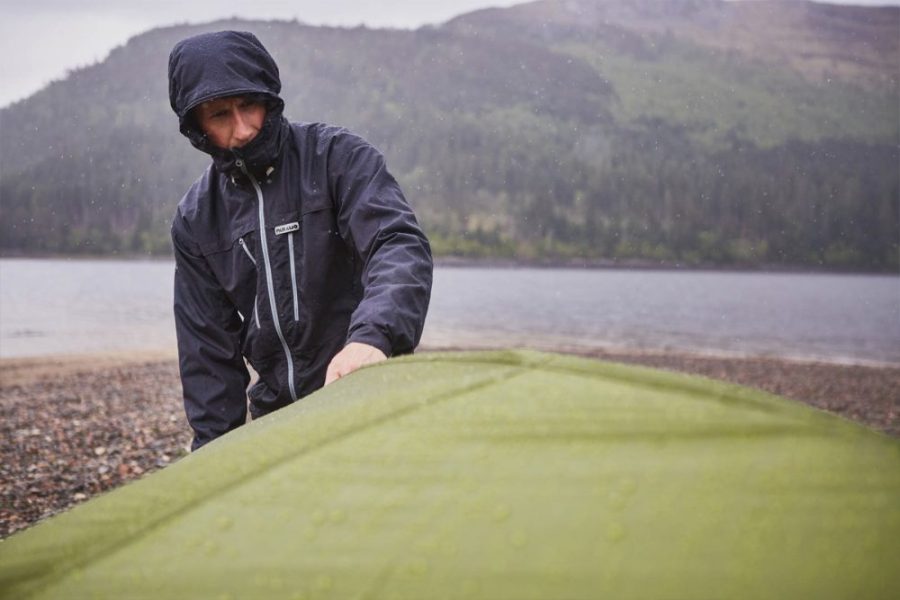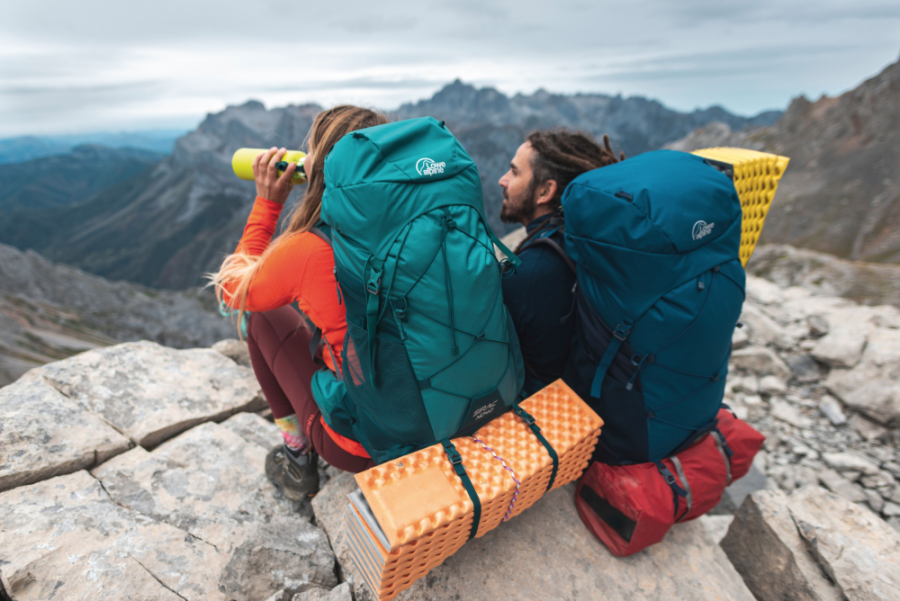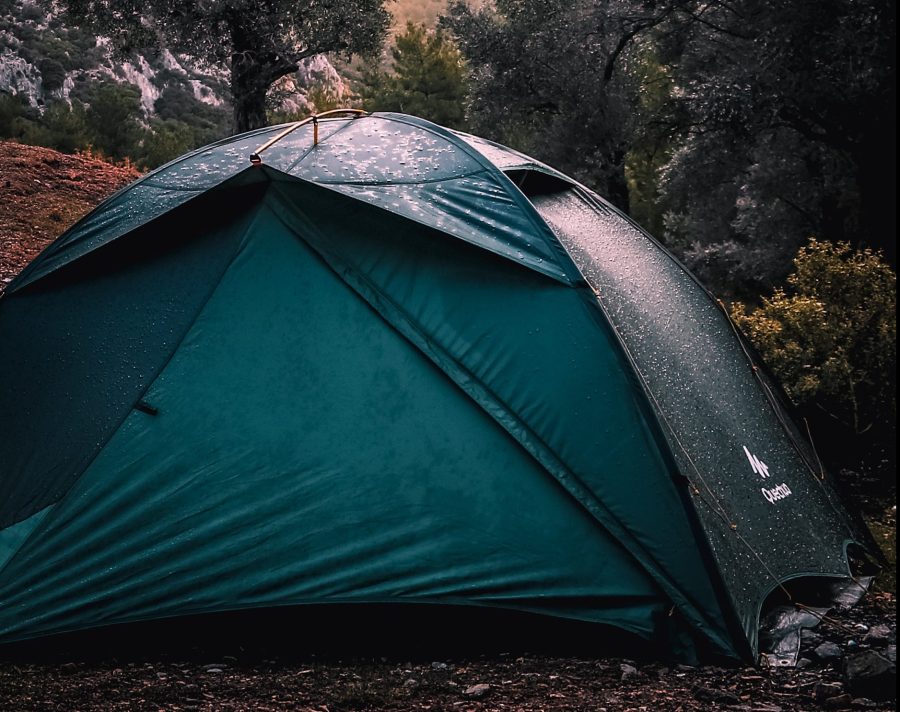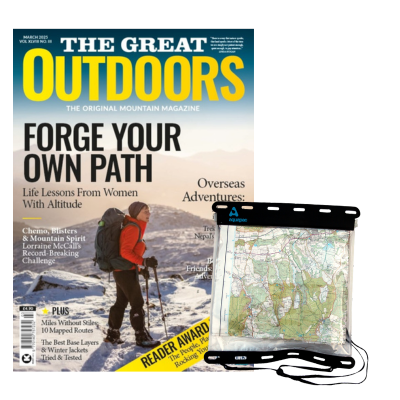Spending time in the great outdoors has many benefits. One of the biggest attractions is the chance to get back to nature. There’s no better way to do this than sleeping outdoors. But it’s not without risk. Many of the most common wild camping worries are about how to stay warm and dry, including a few things that you might be too afraid to ask – such as: “Are sleeping bags waterproof?”
Words: Matthew Jones | Main image credit: Nordisk
Picture the scene: watching the sun dip below the horizon, then sitting out under the stars before you turn in. You slowly drift off in your cosy sleeping bag and are awakened at first light. The warm rays of a spectacular sunrise or the melodious symphony of the dawn chorus.
It’s an unforgettable experience, and it is this that attracts many first-timers or novices to the notion of going camping. Yet swapping your bed at home for a sleeping bag and air mat tends to create a little uncertainty.
So, are sleeping bags waterproof?
The short answer is no – the vast majority of sleeping bags are not waterproof. But they are usually water-resistant, with tightly woven ‘face’ fabrics on the outside of the bag, often treated with durable water-repellent (DWR) finishes. This means they’ll withstand a little moisture, but it is still important to try and keep your sleeping bag dry.
Why? Because a damp sleeping bag will feel cold and clammy. Trapped moisture in the fabrics or fill inhibits its thermal performance – basically, its ability to keep you warm.
This is particularly important for down sleeping bags, which are more susceptible to moisture. It also makes the bag significantly heavier, which is not what you want if you’re backpacking.

Content editor Will testing a jacket by Páramo. Photo: Michael Drummond
If water droplets are soaking into the outer fabric of your sleeping bag, instead of beading up and rolling off, then you can restore the DWR coating at home. Lightly wipe the outer fabric with a damp sponge and then apply a spray-on solution such as Nikwax TX.Direct or Grangers Performance Repel Plus, following the instructions on the bottle.
If you’re in the market for a new sleeping bag, The Great Outdoors’ experts have also got plenty more information on the best bags around, from product reviews to buyer’s guides:
- The best three-season sleeping bags
- How to choose a three-season sleeping bag
- Choosing a sleeping bag
How to keep your sleeping bag dry
The easiest way to keep a sleeping bag dry while it’s in your pack is to keep it in a dry bag or waterproof stuff sack. Premium sleeping bags often come with these (in addition to a bigger mesh bag that is intended for longer-term storage at home). But if your sleeping bag doesn’t have one, here are three of the best dry bags for hiking.
Buy one that is roughly the same volume as your sleeping bag when it is fully compressed (squashed down) to help minimise bulk in your pack.

The LoweAlpine Sirac 65l in the wild. Credit: LoweAlpine
In addition, you can use either a rucksack liner or rain cover to add extra protection from the elements for your sleeping bag (as well as the rest of your hiking and camping gear) when backpacking.
Sleep systems and shelters
Next, consider your sleep system and shelter. When you’re sleeping outdoors, always use a sleeping mat as well as a sleeping bag. A mat provides vital insulation from the cold ground, ensuring you’ll sleep warmer than with a bag alone. It also helps to prevent your sleeping bag from absorbing additional moisture that will otherwise get trapped between the ground and your body.
Tents
If you’re sleeping in a tent, try to ensure that the hood and footbox of your sleeping bag do not brush against the inner walls during the night. Look for a tent that is long enough to accommodate you fully stretched out, and make sure the walls of the tent do not slope in at an angle too much, as this gives less interior space for head and feet.
Another way to stop your sleeping bag from getting wet inside your tent is to maximise airflow through the tent.

A Quecha tent in the rain. Credit: Suat Inan
This will reduce humidity and condensation, minimising the chances of moisture build-up. Look for a tent designed with integrated air vents, as well as an inner with at least some mesh. A bigger gap between the flysheet and the ground also helps to increase airflow.
For more tent pitching advice, read Alex Roddie’s article on how to pitch a tent. And if you’re in the market for a new tent, The Great Outdoors’ experts have also got plenty more information on the best tents out there, from product reviews to buyer’s guides:
Tarps and shelters
Sleeping under a tarp is great for airflow. Here, the greater risk is the possibility of rain creeping underneath and soaking your sleeping bag. To avoid this, pitch it fairly low to the ground if rain is expected.
Similarly, ensure the tarp is long enough to cover both head and feet fully, ideally leaving plenty of room at either end. Popular tarps include the Vango Adventure Tarp, the Vaude Wing Tarp UL, the Terra Nova Competition Tarp 1 and the MSR Front Range Tarp Shelter.
Lastly, if you use a ridgeline to pitch your tarp, make sure that rain won’t run along your ridgeline and then drip onto you in the night. To get around this, some users tie a ‘drip string’ to each end of the ridgeline, while others always sling their tarp beneath the ridgeline, rather than draping it over the top.
Bivi bags
If you’re sleeping without any form of shelter at all, always use a bivvy bag. This is a waterproof but breathable outer shell designed to protect your precious sleeping bag from damp.
Their main advantages are that they are lightweight, compact and discreet, allowing you to bed down for the night almost anywhere. Popular choices include the Terra Nova MoonLite, Rab Ascent Bivi and the Vaude Bivibag Active.

Credit: Chris Townsend
Sleeping bag science: are they waterproof?
But why the need for all these precautionary measures and extra kit? It seems like it would be a better idea just to make sleeping bags waterproof in the first place, right? Unfortunately, there are several issues with this.
Fully waterproof sleeping bags are difficult to manufacture, expensive to produce and fairly impractical to use. You’d need to use shell fabrics with a waterproof coating or a membrane, whilst ensuring that all seams and stitching were fully taped or sealed.
Think about all of the tiny needle holes in the baffling of a down sleeping bag, for example. Taping or seam sealing them all would be very costly. This process would also add weight and bulk while making the bag less comfortable, and probably crinkly and noisy too – not great for a good night’s sleep.
More importantly, however, using waterproof fabrics in a sleeping bag tends to reduce breathability. Although modern waterproof fabrics are marketed as being ‘breathable’, they are actually far less breathable than most of the non-waterproof shell fabrics used in sleeping bags today.
Breathability
Breathability refers to a material’s ability to move moisture vapour. Sleeping bags are constructed to move this moisture through the fabrics and fill, away from the body, thereby keeping you warm, dry and comfortable.
This is important, since the enclosed design of most mummy-style sleeping bags inevitably tends to trap moisture, which your body naturally produces overnight through the processes of evaporation (perspiration or sweating) and respiration (breathing).

Chris Townsend in the Sea to Summit Ascent sleeping bag. Credit: Chris Townsend
No one wants to sleep drenched in their own sweat or in the fug of their own breath, so it’s important that the bag doesn’t trap too much of this moisture.
As an aside, this is one reason why it’s better not to bury your face inside your sleeping bag at night. The moisture in your breath tends to condense inside your bag, causing it to feel cold, damp and clammy. By all means, cinch in the mummy hood of your bag, but try to keep your mouth and nose uncovered.
Trapped moisture in the fabrics and fill of a sleeping bag can also encourage odour-causing bacteria. Over time you might find that your bag starts to smell. One way to avoid this is to use a sleeping bag liner.
Though many campers and backpackers don’t bother with liners. However, they create an effective barrier between you and the difficult-to-clean interior of your bag.
The Great Outdoors’ gear editor Chris Townsend has also written up his top tips on maintaining your sleeping bag.
Gore-Tex sleeping bags
There are a few sleeping bags on the market right now that are marketed as being highly water-resistant. They typically have a shell that incorporates a waterproof membrane, such as Gore-Tex.
Examples include the Mountain Equipment Snowline, Redline and Iceline bags, as well as the Mountain Hardwear Phantom series. But since they lack taped seams, even these bags are still not fully waterproof. These are mostly specialist bags designed for high-altitude mountaineering or polar expedition use.
If you’re heading to such extreme climates, they might be a good option but they might be too much for standard wild camping.
There are many different types of sleeping bag out there. For example, sleeping bags can differ in terms of shape and cut, fabrics and fill, and packed size and weight. Learn more about the types of sleeping bags, whether sleeping bags are waterproof, how to choose a three-season sleeping bag, and our pick of the best three-season sleeping bags from The Great Outdoors’ experts.
For more articles by Matthew Jones, check his bio page out here: Matthew Jones – Writer








